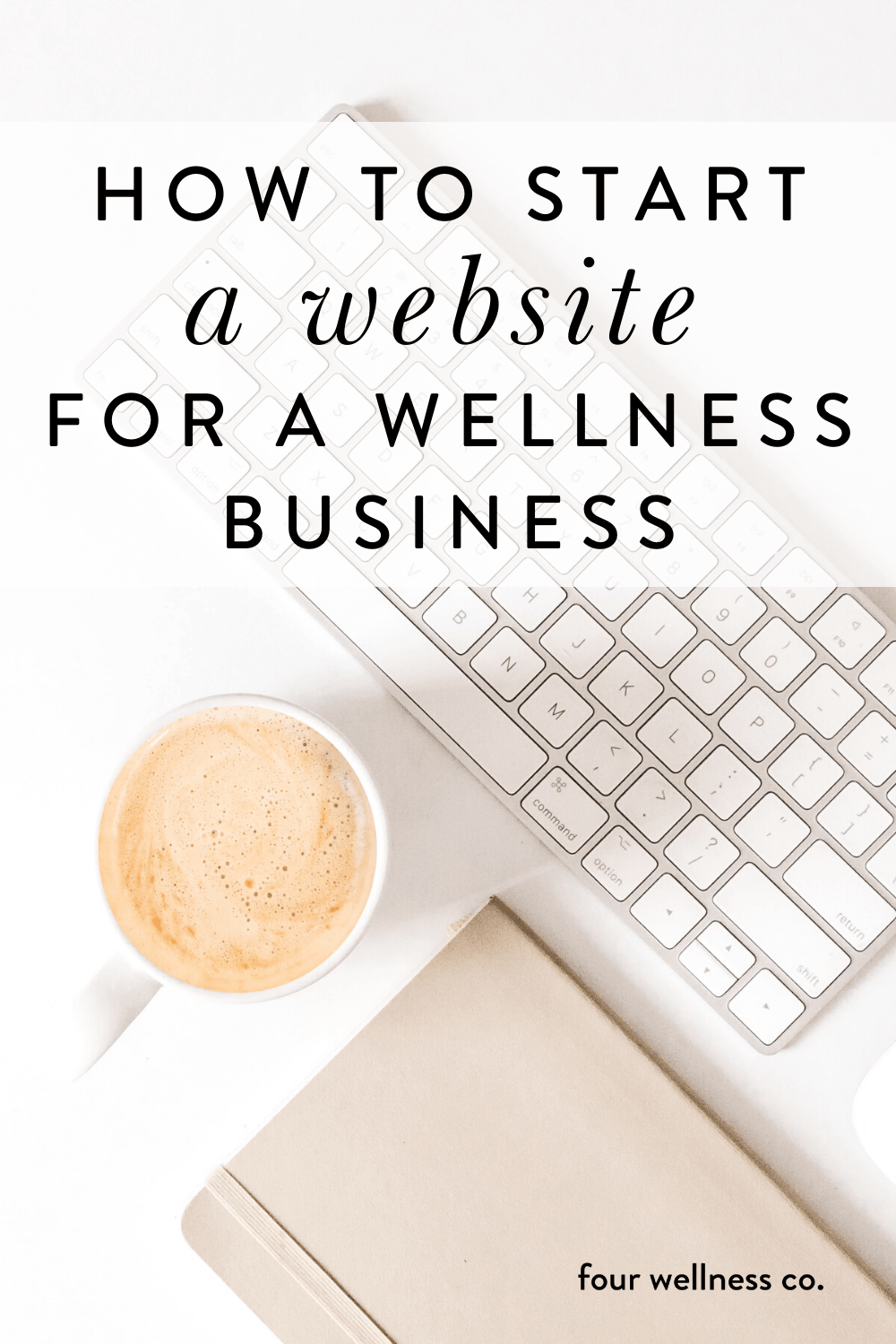How to Start a Website for Your Health Coaching Business
This post contains affiliate links, through which we may earn a small commission if you choose to purchase, at no additional cost to you. We only share products or services we personally use & recommend!
So you’ve started (or are starting!) a health coaching business—yay! 🎉
This is an exciting and oh-so-important time, as you establish your health coaching business branding, your business model, your health coaching business operations, and bring it all together for clients to connect with via your awesome website… you do have an awesome website, right? 😅
I’ve shared before why it’s so important to have a professional website for your health coaching business—and, now, here’s how to actually do that!
10 steps to launch your health coaching website
Building and launching a website can feel like a gigantic, daunting task. (Which, if you do it right, it kind of is!)
But, the best way to eat an elephant is one bite at a time, right?!
Here are 10 simple steps to take your wellness website from zero to published:
1. Clarify your health coaching website goals
Though a quality website is definitely a “must-have” for most wellness businesses these days, there are many different purposes your health coaching website can serve, and it’s important to know what your own purpose is so you can construct your new health coaching website to achieve those goals.
Before beginning, it’s important to get clear on the overall goal of your health coaching website.
For most health coaches offering 1:1 services, the end goal is to attract your ideal client and interest them in booking your health coaching services. However, you may also have the goal of building a mailing list to which you can eventually promote other health coaching or wellness offerings you’ll create.
Here’s a list of common website goals for health coaches and wellness professionals—there’s no “correct” combination, just pick the ones that apply to your particular wellness business:
Establish + promote your brand as a health coach
Sell 1:1 health coaching services
Sell other wellness products (digital products, online courses, etc.)
Grow your email list
Provide helpful information to your niche to establish your authority as a wellness expert
Grow your health coaching client base
Attract wellness brands or other businesses for potential partnerships
Serve as a hub of wellness resources or information for your existing health coaching clients
2. Choose your health coaching website platform
There are a wide range of build-your-own website platforms available to DIY your health coaching website. Some of the most popular are Squarespace, WordPress, Wix and Weebly.
While each of these has its own benefits and drawbacks, I use and recommend Squarespace because I think it’s the best combination of being:
Simple & easy to maintain: A beautiful website isn’t very useful if it’s not updated and maintained to meet its purpose—telling your brand story, showcasing your services, and evolving to meet the needs of your business.
Design-oriented: Squarespace websites are structured with an eye for simple, clean design, which tends to work particularly well for health coaching websites, which emphasize impactful imagery and text.
Compatible with many helpful business integrations: Squarespace makes being a health coach or wellness professional with multiple business needs (e-commerce, email marketing, appointment scheduling, membership programs, etc.) much easier than it could be. Their built-in integrations allow health coaches to connect to various other platforms to seamlessly integrate your email marketing, appointment scheduling, sales and more.
Tech-friendly: One of the best things about Squarespace for new health coaches is that you don’t have to worry about any of the technology on the back-end of your site. Your website will be kept up-to-date with the Squarespace platform, and Squarespace offers helpful tech support if you do ever run into any technical difficulties.
Streamlined management: Other website platforms (we won’t name names 😉) require hosting your website elsewhere. Squarespace allows you to purchase your domain name, build your website, set up your business email address, etc. all from the Squarespace dashboard. This is great for keeping everything easily accessible in one place and making sure your website subscription or domain renewal never expires.
Great for blogging & SEO: One of the top things I recommend to new health coaches looking to grow an audience for your health coaching business is to publish regular, helpful blog content (on topics relevant to your health coaching services) and invest in optimizing your website’s SEO. Squarespace makes both blogging, and the search engine optimization (SEO) associated with it a breeze.
Though it’s possible to transfer your website and domain to another platform, it can be tricky and time-consuming to do so, so it’s best to do your research and start your health coaching website on the platform you envision staying with for the foreseeable future.
Use code PARTNER10 for 10% off the first year of your Squarespace website subscription.
3. Select your website template
Another key step before beginning to design your health coaching website is researching the available template or theme options on your chosen website platform and choosing the one that best supports your business’ branding and needs.
Though Squarespace makes it possible (and relatively easy) to switch between templates after you’ve started to design, there are some elements that can get lost in translation when switching, so starting with a template you’re confident will work for you is helpful.
Things to look for in choosing the best template for your health coaching website:
Navigation layout options (for example, do you want a button in your navigation bar?)
Blog layout
Mobile layout and navigation format
Page layout (do you want banner images? a sidebar? index pages?)
Site styling options (what you’re able to customize easily within the template)
A good starting point is to take a look around Squarespace’s template demos. They also have helpful documentation on understanding some of the back-end differences between different templates. Note that Squarespace template differences apply only to their legacy Squarespace 7.0 templates, as Squarespace 7.1 templates are all structured with the same functionality and design settings.
4. Purchase your domain name
The next step is to choose your website’s domain name (its “web address”), ensure it’s available, and secure it!
But, before setting your health coaching business name in stone, it’s a good idea to check its availability in a few key places:
Domain: Is the domain name available? (Search squarespace.com/domains to see what’s available for purchase.) Are there other active websites with a similar domain that might be confusing?
Legal entities: If you plan on incorporating your health coaching business as an LLC (either now or somewhere down the road), you’ll want to be sure your business name is not already taken (and that it’s not too close to an existing name in your state). The process for checking incorporated business names varies by state.
Social names: You’ll also want to check that any social platforms you plan to use have a handle available for you—ideally, your name or the name of your business.
You can search for and purchase your domain name through Squarespace at squarespace.com/domains. Note: Though you can purchase a domain elsewhere and transfer it to a Squarespace website, purchasing your domain through Squarespace will make it extra easy to connect in the back-end of your site later.
5. Establish your basic branding guidelines
Next, your health coaching website needs a brand!
Though many people find this to be a more fun and creative part of the process, it’s also super important for informing and setting up later steps in your website creation as well. Ultimately, the process of designing your website will be much simpler and more efficient if you start with clear brand guidelines, like your color palette, font scheme, and image aesthetic.
While it’s helpful to actually create a brand style guide for your health coaching business, it’s also completely okay if, as you’re just starting out, your brand style may still be evolving and not entirely clarified yet.
To streamline the design of your website, here are some basic branding questions that are helpful to answer:
What are my primary fonts? (The happy number is usually two—one serif, one sans serif.)
What are my primary accent colors? How will these be used throughout my site (links, buttons, etc.)?
What is the key feeling people should experience when visiting my site? How can I use color, font, imagery and layout to enhance this message?
What type of imagery best expresses my brand? Photography, graphic icons, or both? What aesthetic do I lean toward for these?
Your process for answering these questions can be very simple (a quick brainstorming session to clarify your preferences before getting started), or you can spend more time researching and compiling brand inspiration and formally crafting the guidelines you’ll work with moving forward. Either way, it’s important to have a clear plan for your vision of the site’s aesthetic and how you’ll keep that cohesive and consistent as you begin to build out your pages.
In health coaching, you’re selling (and, therefore, marketing) a feeling—a particular outcome you help your health coaching clients achieve. Whether that’s feeling healthier, happier, more relaxed, or more fit, your health coaching website and overall business branding should be designed to reflect the particular feeling your health coaching clients are looking to achieve by working with you.
6. Outline your webpage structure + content
One more piece to setting a strong foundation for your health coaching website: planning and outlining your webpage structure and content.
What page topics will you need? How will your site navigation menu be organized? What are your key categories of content, and will you have subcategories in your navigation? How do you want users to flow throughout your site?
Here are the basic pages I recommend for health coaches (though, of course, you may need to add/remove as necessary for your particular business model):
Home
About
Services
Blog
Contact
If you’re just starting out, it’s a good idea to keep things simple. You can always add additional content down the road as you develop it—don’t feel like you have to create all of your eventual programs, services and income streams before you can get your website up and running!
The key initial pages to have on your health coaching website are:
your homepage (also referred to as a landing page)—think of this as a quick, high-level overview of your health coaching business
your About page (who you are, your area of expertise, and what you offer of value or interest to your website visitors)
a way to contact you (though this could simply be added to your home or About page)
and your blog—your blog is one of the most important pieces of growing your website’s SEO and connecting you with a broader audience, so it’s a great idea to get it started as soon as possible and begin attracting traffic from your target audience
You can actually work on building out your health coaching services, how they’ll be structured and the webpage(s) and checkout process you’ll need for them after launching the initial parts of your website above.
Many people believe they can’t launch their health coaching website until there’s something there to purchase, but that’s not true at all!
It’s a great idea to begin adding blog content and growing your audience (and email list) as you continue finalizing your coaching set-up and other parts of your business or website.
Whether you plan to launch the core content of your website all at once or in phases, you’ll want to plan out how all the pieces will ultimately fit together. As you’re outlining the content areas you’ll need on your site, map out how you’d like visitors (aka potential health coaching clients!) to flow through these parts of your website.
It can be helpful to draft your website content in a word processor prior to building out your site—for example, write your About section, summaries of your service offerings, etc.—so you can see all of your content in sum and understand how it fits together.
7. build your health coaching website!
Now we dive in! 😄 With your site outline in mind, begin building out the pages of your website and the layout and structure of each page. This is more of a drafting phase, as you’ll polish and refine content and design in a later step—but create the structure and draft the content of each page.
A few tips as you do this:
Page titles & URLs: Thoughtfully choose the Page Title and URL Slug for each page on your website. URL slugs should somewhat closely match your Page Title; they should also be full words and separated by hyphens if they’re multiple words. For example, an About page could be titled “About” with the URL /about or “About Us” and the URL /about-us.
Mobile design: With mobile searches growing steadily, you can expect to receive about half of your website traffic from mobile devices. This means it’s super important that your website looks great on mobile. And, your life will be much easier down the road if you design your site to be mobile-friendly from the start. Use the device view toggle in Squarespace’s editing interface to toggle between desktop, tablet and mobile styles and ensure your layout looks great on them all.
User experience: Keep in mind the desired flow of traffic through your site, and ensure you’re building in any necessary transitions or calls-to-action to guide users along the way.
8. Stylize your website
The reason we wait until your content has been inputted into your website to work with your site’s style settings is that it’s helpful to view the settings (and tweak them if needed!) with your actual content, rather than an empty page or placeholder text. This helps you assess how your header font looks with your body font in your page structure, how your button color works with your photos, etc.
Depending on the template you selected and the branding guidelines you developed, you may need to adjust only some of your site’s style elements—but here’s what you’ll want to make sure is styled to match your desired branding throughout your website:
fonts (heading & body font styling, navigation font, button font)
link color & font styling
button color & sizing
image size & styling
site title or logo
mobile menu font, color & layout
Just like you did above with your page layout, make sure to review the design styles for your entire site on desktop, mobile and tablet screen sizes.
9. Create “starter” blog content
As I’ve mentioned before, like a broken record: your wellness blog is one of the best ways to drive traffic to your health coaching website.
Before launching your site, try to publish 4-6 blog posts that are representative of your health coaching work, your brand identity, and what you can offer prospective health coaching clients. We have an entire post on how to use your blog content to attract your ideal health coaching client (+ some specific blogging tips for health coaches!), but the key points to keep in mind for your “starter” wellness blog content are:
Keep your blog posts relevant to the problems of your target health coaching audience. What are they concerned about? What are they searching online for answers to? Construct your blog posts around a clear solution to a wellness problem your actual audience faces.
Keep it simple. Try to reduce a larger problem into smaller, more digestible pieces and steps to the solution. (For example, don’t feel that you need to tackle How to Lose Weight and Keep It Off in one of your first blog posts—aim for a smaller, more tangible piece of this broader topic, such as 5 Tips for Crowding Out Junk Food with Healthier Options, etc.)
Relate your blog post content to your health coaching services and opt-in gift (more on that in a moment!). Your blog post should be step one of the solution, with further value added via your opt-in gift (step two), and eventually your health coaching services (a later step, depending on the number of items in your sales funnel).
10. Add an opt-in gift
And, finally, before launching your website and working to drive traffic to it, establish a specific opt-in gift (“freebie” or “lead magnet”) offer that can convert your website visitors into mailing list subscribers.
You only need to start with one good opt-in offer—though, of course, you can add more down the road!
Try to keep your opt-in offer specific enough that it’s “bite-sized” (i.e. it can be easily understood and used within five minutes), yet broad enough that it’s relevant to most of your starter blog content (so you can include it on most of your posts).
Your opt-in gift can be a free downloadable checklist, access to a video tutorial, a collection of healthy recipes, etc. Here’s a list of our favorite opt-in gift ideas for health coaches, and our tips on where (and how!) to add opt-in offers around your website.
Publish your health coaching website!
Alright! You’ve set up a strong structure for your website, established your branding guidelines, outlined and created your content, added it to your website, and you have an opt-in for your first website visitors. You’re ready to launch! 🤗
(Of course, before hitting publish, just make sure you’ve checked off all items on the free checklist below!)
Perfect your health coaching website
Grab my free checklist for optimizing your wellness website!
It’s got all the big picture must-haves (& all the important little details!) to make your health coach website shine. ✨












